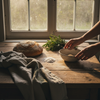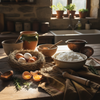Chef Recommended Spatula Turner Set: Ultimate Guide 2025
Key Takeaways
- The right chef recommended spatula turner set is essential for perfect flipping, lifting, and smashing in cooking.
- Using high-quality tools elevates dishes from good enough to absolutely perfect.
- Most home cooks use basic tools, but serious chefs invest in award-winning spatula turner sets.
- This guide is designed for home chefs who want to cook boldly and safely in 2025.
Table of Contents
- Spatula vs. Turner vs. Fish Spatula: Clear Definitions for Confident Choices
- What Should a Chef-Recommended Spatula Turner Set Include?
- Materials Showdown: Silicone, Stainless, Nylon, and Wood Performance
- Wood and Composite Options
- Heat Resistance and Temperature Limits: Cook Boldly, Not Recklessly
- Handle Ergonomics and Control: Comfort You Can Feel
- Head Design Deep Dive: The Geometry of a Great Flip
- Surface Compatibility: Protect Your Pans, Boost Your Results
- Safety and Compliance: Health-First by Design
- Maintenance and Longevity: Keep Your Tools Gold-Standard
- Use Cases by Cuisine and Task: Match the Tool to the Moment
- How to Choose a Chef-Recommended Spatula Turner Set for Your Kitchen
Chef-Recommended Spatula Turner Sets: The Ultimate Buyer's Guide for Home Chefs Who Cook Boldly and Safely in 2025
The perfect flip, the delicate lift, the crispy-edge smash burger—every memorable dish starts with the right chef recommended spatula turner set. While most home cooks settle for whatever came in their starter kitchen bundle, serious creators know that award-winning tools make the difference between "good enough" and "absolutely perfect."
DI ORO™ partners with home chefs who dream big and cook with heart, delivering America's Test Kitchen award-winning spatulas made with pro-grade, forever-chemical-free silicone. Our tools aren't just heat-resistant to 600°F—they're designed for creators who refuse to compromise on performance, safety, or results.
By the end of this guide, you'll know exactly which chef-recommended set fits your cookware, cooking style, and culinary ambitions—without exposing your food to anything it shouldn't touch.
Spatula vs. Turner vs. Fish Spatula: Clear Definitions for Confident Choices
Confusion starts in the kitchen aisle where "spatula" describes everything from silicone scrapers to metal flippers. Professional kitchens use precise terminology because the right tool determines success.
What Is a Spatula?
A true spatula features a flexible silicone or rubber blade designed for mixing, folding, and scraping bowls and pans. Think batter incorporation, sauce reduction scraping, and gentle folding of delicate ingredients. DI ORO's seamless silicone spatulas excel here with their bacteria-resistant, one-piece construction.
What Is a Turner?
Turners feature flat, rigid blades engineered to slide under food and flip or lift with precision. Available in slotted (for drainage) or solid (for maximum support) configurations, quality turners like those recognized by Food Network combine thin beveled edges with structural integrity.
What Is a Fish Spatula?
The fish spatula—a thin, flexible, beveled turner often with an offset angle—represents precision engineering for delicate proteins. Its slots drain excess oil while the ultra-thin edge slides under fragile items without breaking the surface tension.
Pro Insight: Match tool geometry to task demands. Thick pancakes need wide, thin turners. Delicate fish requires beveled flexibility. Smash burgers demand rigid leverage.
What Should a Chef-Recommended Spatula Turner Set Include?

Professional-grade sets balance versatility with specialization, covering 90% of cooking tasks without drawer clutter.
The Essential Core (Minimum Viable Set)
Standard slotted turner: Handles everyday flips with built-in drainage for oils and liquids. Look for heat resistance to 600°F and nonstick-safe edges.
Fish spatula: The precision instrument for delicate proteins, eggs, and fragile items. Thin, flexible, and beveled for clean releases.
Silicone scraper: Mix, fold, and scrape with complete bowl contact. Seamless construction prevents bacterial buildup—a DI ORO specialty.
Professional Additions
Wide pancake turner: Supports crepes, latkes, and delicate baked goods with maximum surface contact and minimal pressure points.
Long slotted turner: Extends reach for sheet pan roasts, large skillets, and high-heat applications where hand protection matters.
Sets with 5-7 pieces serve serious home chefs who cook diverse cuisines and use multiple cookware types. Beyond seven pieces typically adds redundancy unless you're grilling frequently or running a household that cooks in large batches.
Materials Showdown: Silicone, Stainless, Nylon, and Wood Performance
Material choice determines heat tolerance, cookware compatibility, and long-term durability. Each excels in specific applications.
Silicone: The Nonstick Guardian
Pro-grade silicone like DI ORO's LFGB-certified blend handles temperatures up to 600°F while protecting nonstick surfaces. Forever-chemical-free formulations ensure food safety, while flexible edges conform to pan curves for complete scraping.
Best for: Nonstick cookware, high-heat sautéing, bowl scraping, gentle protein flips, and dishwasher convenience.
Stainless Steel: The Searing Specialist
Stainless steel turners provide unmatched rigidity for leverage-demanding tasks. Ultra-thin beveled edges slide under proteins while maintaining structural integrity for heavy lifting.
Best for: Cast iron searing, smash burgers, crispy-edge proteins, and fond scraping. Avoid with nonstick surfaces.
Nylon: Budget Compromise
Standard nylon offers basic nonstick compatibility at lower price points but sacrifices heat tolerance and durability. Most nylon turners warp above 400°F and lack the precision bevels found in professional tools.
| Material | Heat Rating | Nonstick Safe | Dishwasher Safe | Best Application |
|---|---|---|---|---|
| Pro-Grade Silicone | Up to 600°F | Yes | Yes | All-purpose, nonstick protection |
| Stainless Steel | No limit | No | Yes | High-heat searing, precision |
| Standard Nylon | Up to 400°F | Yes | Yes | Budget nonstick use |
Wood and Composite Options
Wood: Offers gentle pan contact and comfortable grip feel but requires hand-washing and periodic seasoning. Limited precision due to thicker bevels.
Composites (nylon/fiberglass blends): Improve rigidity over standard nylon while maintaining nonstick compatibility. Heat tolerance remains below premium silicone ratings.
Material Selection Matrix: Nonstick-centric kitchens prioritize silicone sets. Cast iron enthusiasts add stainless fish spatulas. Mixed cookware demands hybrid collections combining both materials for complete coverage.
Heat Resistance and Temperature Limits: Cook Boldly, Not Recklessly

Temperature ratings determine whether your turner survives high-heat searing or melts into your pan. Understanding these limits prevents tool failure during critical cooking moments.
Silicone Temperature Advantage
Premium silicone formulations like DI ORO's pro-grade blend withstand continuous contact up to 600°F—exceeding most stovetop and oven applications. This heat tolerance enables oven-finishing techniques and high-temperature sautéing without tool degradation.
Material Heat Comparison
Standard nylon: 400°F maximum before warping begins. Avoid resting on hot pan edges or leaving in preheated ovens.
Stainless steel: Virtually unlimited heat tolerance for direct cooking applications. Handle materials determine overall tool limits.
Wood: Heat-resistant heads with comfortable grip temperatures, though prolonged high heat can cause cracking or splitting.
Quality manufacturers clearly label temperature ratings. Tools without specified limits typically use lower-grade materials prone to premature failure.
Handle Ergonomics and Control: Comfort You Can Feel
Superior handle design reduces wrist fatigue during extended cooking sessions while providing secure grip control for precise food manipulation.
Grip Technology and Materials
Silicone-wrapped handles offer slip resistance even with wet or oily hands while providing thermal insulation during high-heat cooking. Stainless steel cores within silicone handles deliver strength without compromising comfort—a hallmark of America's Test Kitchen's most versatile spatula recognition.
Length and Leverage Considerations
11-13 inches: Optimal for everyday stovetop cooking with standard cookware sizes.
14-16 inches: Extended reach for sheet pan work, large skillets, and high-heat applications requiring hand protection.
16+ inches: Specialized for grilling and outdoor cooking where heat distance matters.
Balanced weight distribution prevents tip-heavy tools that strain wrists during repetitive flipping. Quality handles feature smooth seam integration to prevent hot spots or pressure points during extended use.
Head Design Deep Dive: The Geometry of a Great Flip
Head geometry determines sliding capability, food support, and release precision. Professional-grade designs optimize each element for specific cooking tasks.
Slotted Versus Solid Configuration
Slotted heads drain excess oils and liquids while lifting, ideal for bacon, fried foods, and sautéed vegetables. Solid heads provide maximum surface support for delicate pancakes, fish fillets, and items requiring uniform pressure distribution.
Beveled Edge Engineering
Ultra-thin bevels—measuring less than 1mm at the edge—slide under eggs and delicate proteins without surface disruption. Thicker bevels provide structural strength for heavy lifting but sacrifice precision entry.
Offset head angles improve leverage by positioning the handle above the cooking surface, reducing wrist strain and enhancing control during flipping motions. Straight heads offer predictable control on flat surfaces but may limit access in deep pans.
| Head Feature | Best Application | Key Benefit | Avoid For |
|---|---|---|---|
| Thin Bevel + Flexible | Eggs, delicate fish | Clean release without breaking | Heavy proteins, leverage tasks |
| Rigid + Slotted | Bacon, fried foods | Drainage plus support | Pancakes, crepes |
| Wide + Solid | Pancakes, latkes | Maximum surface contact | Tight pan corners |
| Offset + Beveled | Searing, smash burgers | Leverage plus precision | Shallow pan work |
Surface Compatibility: Protect Your Pans, Boost Your Results
![]()
Matching turner materials to cookware surfaces prevents damage while optimizing cooking performance. Wrong combinations scratch coatings or fail to deliver necessary leverage.
Nonstick Cookware Protection
Nonstick surfaces demand silicone or other soft-edge materials to preserve coating integrity. DI ORO's seamless silicone construction eliminates sharp seams that could score delicate surfaces while maintaining the flexibility needed for complete pan contact.
Cast Iron and Stainless Steel Performance
Cast iron and stainless cookware benefit from stainless steel turners that scrape fond effectively while providing leverage for crusty sears. The rigidity enables proper browning techniques impossible with flexible materials.
Grill grates: Require long-handled, rigid tools for safety and control over high heat.
Sheet pans: Work best with long, slotted turners that provide reach and support for roasted items.
Mixed cookware collections require hybrid tool sets combining silicone protection with stainless precision—exactly what professional kitchens maintain for complete cooking versatility.
Safety and Compliance: Health-First by Design
Professional-grade chef recommended spatula turner sets prioritize food safety through material certification and manufacturing transparency. What touches your food directly impacts your family's health—making material selection a critical decision beyond performance alone.
Pro-Grade Silicone Standards
LFGB certification represents Europe's strictest food contact standards, surpassing basic FDA requirements. This certification ensures silicone formulations remain chemically stable under heat stress without leaching compounds into food. DI ORO's commitment to award-winning spatula construction includes pro-grade silicone meeting these elevated standards.
Forever-Chemical-Free Commitment
Forever chemicals (PFAS) create non-stick properties in some kitchen tools but accumulate in human tissue over time. Quality manufacturers explicitly state forever-chemical-free formulations, providing transparent ingredient disclosure rather than vague "non-toxic" claims.
Seamless construction prevents water intrusion and bacteria buildup in handle joints—a common failure point in lower-grade tools. One-piece molding or hermetically sealed assemblies ensure dishwasher safety without compromising structural integrity.
Safety Verification: Reputable brands provide clear heat ratings, material certifications (LFGB, BPA-free), and explicit forever-chemical-free statements. Avoid products with vague safety claims or missing temperature specifications. For more on the health impacts of PFAS, see the FDA's resource on PFAS in food.
Maintenance and Longevity: Keep Your Tools Gold-Standard
Proper care extends tool lifespan while maintaining food safety standards. Different materials require specific maintenance approaches to preserve performance characteristics.
Silicone Care Protocols
High-grade silicone handles full dishwasher cycles without degradation. For stubborn odors or staining from turmeric or tomato-based sauces, create a baking soda paste and let sit for 30 minutes before scrubbing with non-abrasive tools. For more tips on keeping your utensils spotless, check out this guide on easy to clean seamless spatula set.
Stainless Steel Maintenance
Hand-dry stainless components immediately after washing to prevent water spots. Use non-abrasive scrubbers to maintain beveled edges—scratched bevels lose their precision sliding capability.
Storage Protection: Utensil caddies provide quick access while protecting beveled edges from drawer damage. Avoid stacking heavy items on flexible silicone heads, which can cause permanent deformation.
Replace tools when edges show nicks, warping, or flexibility loss. Damaged edges scratch cookware and fail to provide clean food release—compromising both performance and surface protection.
Use Cases by Cuisine and Task: Match the Tool to the Moment

Specific cooking techniques demand precise tool selection for optimal results. Professional chefs match turner characteristics to food types and cooking methods rather than using universal approaches.
Delicate Protein Techniques
Eggs and omelets: Thin-beveled fish spatulas or flexible silicone turners slide under delicate proteins without breaking yolk integrity.
Skin-on fish fillets: Stainless steel fish spatulas provide the rigidity needed to maintain crispy skin while offering precision control for intact presentation.
High-Heat Searing Applications
Smash burgers: Rigid stainless turners deliver the leverage required for proper crust formation while scraping fond effectively.
Stir-fry vegetables: Slotted turners drain excess moisture while maintaining high-heat cooking speeds essential for proper texture.
Sheet pan roasting: Long slotted turners provide reach and stability for large-format cooking without crowding workspace.
| Cooking Task | Optimal Turner Type | Key Feature Required | Material Priority |
|---|---|---|---|
| Pancakes/Crepes | Wide, thin silicone | Maximum surface contact | Flexible, nonstick-safe |
| Fish Fillets | Beveled fish spatula | Precision entry angle | Stainless for rigidity |
| Bacon/Fried Foods | Slotted turner | Grease drainage | Heat-resistant, easy-clean |
| Grilled Proteins | Long-handle rigid | Heat protection + leverage | Stainless with insulated grip |
How to Choose a Chef-Recommended Spatula Turner Set for Your Kitchen
Systematic selection ensures your investment matches actual cooking patterns rather than aspirational purchases. Professional approach focuses on frequent-use scenarios before specialty applications. For more advice on assembling the ideal kitchen toolkit, see this resource on the kitchen utensil set.
Step 1: Cookware Audit Process
Document your primary cookware materials and sizes. Nonstick-dominant kitchens prioritize silicone-heavy sets, while cast iron enthusiasts require stainless steel options for proper fond management and leverage.
Step 2: Cooking Pattern Analysis
List your five most frequent cooking tasks weekly. Choose turner heads that directly serve these applications—avoiding specialty pieces that address occasional needs before covering daily requirements.
Step 3: Heat Requirement Assessment
High-heat searing, grilling, or oven-finishing techniques demand 600°F-rated tools. Standard sautéing and medium-heat cooking accommodate lower temperature ratings with cost savings.
Step 4: Set Sizing Strategy
3-4 pieces: Essential coverage for basic cooking needs—slotted turner, pancake turner, scraper spatula.
5-7 pieces: Comprehensive home chef toolkit adding fish spatula and specialty heads for diverse techniques.
8+ pieces: For culinary enthusiasts or large households, consider sets with additional specialty turners for grilling, baking, or international cuisines. Avoid overbuying unless your cooking style truly demands it.
Frequently Asked Questions
What are the key differences between a spatula, a turner, and a fish spatula, and how do I choose the right one for specific cooking tasks?
A spatula typically has a flexible silicone blade ideal for scraping, mixing, and folding, while a turner features a flat, sturdy surface designed for flipping and lifting foods like pancakes or burgers. A fish spatula is thinner and slotted, perfect for delicate tasks like turning fish without breaking it. Choose based on your cooking needs: use spatulas for mixing and scraping, turners for flipping and lifting, and fish spatulas for delicate, precise turns.
What materials should I look for in a chef-recommended spatula turner set to ensure heat resistance, durability, and safety?
Look for pro-grade silicone or stainless steel, as these materials offer excellent heat resistance—up to 600°F for silicone—and durability without bending or melting. Ensure the silicone is forever-chemical-free, BPA-free, and LFGB certified for food safety. Avoid materials that scratch cookware or degrade quickly to keep your kitchen tools performing at their best.
How do ergonomic handle design and head geometry impact the performance and comfort of spatula turner tools?
Ergonomic handles provide a comfortable grip and precise control, reducing hand fatigue during extended cooking sessions. Thoughtfully designed head geometry—like angled edges or flexible blades—ensures smooth flipping, lifting, and scraping while protecting cookware surfaces. Together, these features make cooking easier, more efficient, and more enjoyable.
What maintenance practices help extend the longevity of high-quality spatula turner sets while keeping them safe for food contact?
Regularly hand wash or use the dishwasher if the tools are dishwasher safe, and avoid abrasive scrubbers that can damage silicone or coatings. Store tools properly to prevent bending or warping, and inspect them periodically for wear. Following these steps preserves performance and ensures your tools remain safe and ready for bold cooking adventures.




